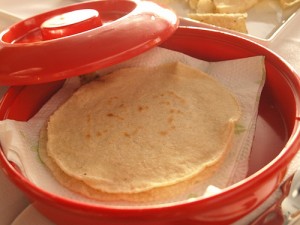Tejano Food Can Be Healthy, Too
Many years ago, as a college student to be exact, I developed an ulcer. The doctor placed me on a special diet that I immediately questioned. My concern was that the prescribed diet did not include a single Tejano dish or item! I jokingly asked if having an ulcer was a non-Hispanic malady or if Hispanics did not get ulcers. He assured me the prescribed diet was the best and I had to follow it for six months. Consequently, for six very long months I stuck to the most bland, tasteless diet until the ulcer was gone. Six months and one day later, I attacked my favorite bean and bacon tacos, calabacita con puerco (squash or zucchini with pork), flour tortillas, super hot salsa and all those Tejano dishes I had denied myself for six torturous months.
I was reminded of this not long ago when sitting at a doctor’s waiting room and picked up a brochure by Merck Pharmaceutical Company. The foldout is title “7 Days of Simply Healthy Meals” created by two nutritionists, one of who is associated with John Hopkins Bay view Medical Center. The 7 day plan is to keep a person to 2,000 calories but not recommended for people with kidney problems.
As interesting as the foldout looks and sounds, I found it amazing not to contain a single outright Tejano dish even though it is distributed in South Texas and specifically the Winter Garden Area. The nearest entry in the foldout that might be considered quasi-Tejano is “Grilled pork with veggies”. This recipe calls for 3 ounces of pork tenderloin, 1 cup mixed zucchini and yellow squash, half cup grilled sweet potato slices, and one tablespoon of trans-fat free margarine. This recipe caught my attention as it reads like a recipe calabacita con puerco. Bear in mind, the Tejano dish can also be prepared with bite size pieces of chicken, armadillo or jabalina.
Two recipes that try to sound Tejano or Tex-Mex but fail miserably are “Turkey Chile” and the outrages “Tuna Wrap”. The so called chili calls for canned vegetarian chili with beans” topped with low fat cheddar cheese. Perhaps some people prepare and eat this on the East Coast or health conscious San Francisco, California area, but not in South Texas and especially not in San Antonio, Texas where chile con-carne originated. Likewise, for some strange yet to be explained reason, some people outside of Texas and New Mexico have taken to calling tacos “burritos” and tortillas are called “wrap”. This leads us to the “Tuna Wrap” recipe that calls for 3 ounces of water-packed (canned) tuna, 4 tablespoons of mayonnaise, 2 tomato slices and one dark-green lettuce leaf rolled into one flour tortilla! Excuse me, I am happy to learn the dieticians like flour tortillas but in South Texas we serve tuna fish as a salad or sandwich and not in a tortilla. So don’t patronize me. Incidentally, the black bean vegetable soup starts off on the wrong foot by calling for a can of beans. The rest of the ingredients are not worth discussing.
It is precisely this type of so called educational material comical and irrelevant to the population of South Texas, Winter Garden Area, Rio Grande Delta and I am sure, New Mexico that prompted the two cookbooks being developed. Moreover, the Manual developed and about to be released by the University of Texas – Panamerican at Edinburg, Texas specifically deals with the nutritional value of Tejano – Tex-Mex ingredients. Finally, there are sites on the internet listing “healthy Mexican” dishes. Unfortunately, not all recipes listed on the internet can be verified.
If the medical profession is sincere in fighting diabetes and obesity, then they should make educational material relevant to the population and not some idealistic, upper socio-economic, East Coast and West Coast group. Let them continue to buy their tamales, beans, enchiladas and chile-con-carne in cans, but in our area regardless of a family’s ethnic-racial or language of the home background, we hand prepare them at home. So, well-intended Medical profession, doctors, nurses, dietitians and clinics, give the people realistic healthy menus and recipes that we can prepare at home. You may continue to call a tortilla a wrap and a taco a burrito, but consider the nutritional value of chile piquin, fresh serrano peppers, nopalitos (cactus pad), tuna (prickly pear and not the canned fish), calabacita (squash and zucchini), caldo (beef, fish or chicken soup) and no sodium corn tortillas as opposed to store bought flour tortillas that will not even puff up when heated and taste like cardboard (perhaps those are the “wraps”) as served in fast-food businesses.
One final word of advice to the medical profession that is, buy a wrist watch or a wall clock. When you set an appointment for a specific time, please do not make the person sit one to two hours in the waiting room before they are taken to an examining room where they wait for another 15 to 45 minutes before the doctor waltzes in, does his examination and prescribes medication in about ten minutes. And get better reading up-to-date material instead of last year’s throw away magazines and health tips that seem comical and irrelevant to South Texas patients. So let’s get serious about fighting diabetes, obesity and health problems.
He dicho.
Richard G. Santos is a writer who lives in Pearsall, Texas.
[Photo By The Travelista]

